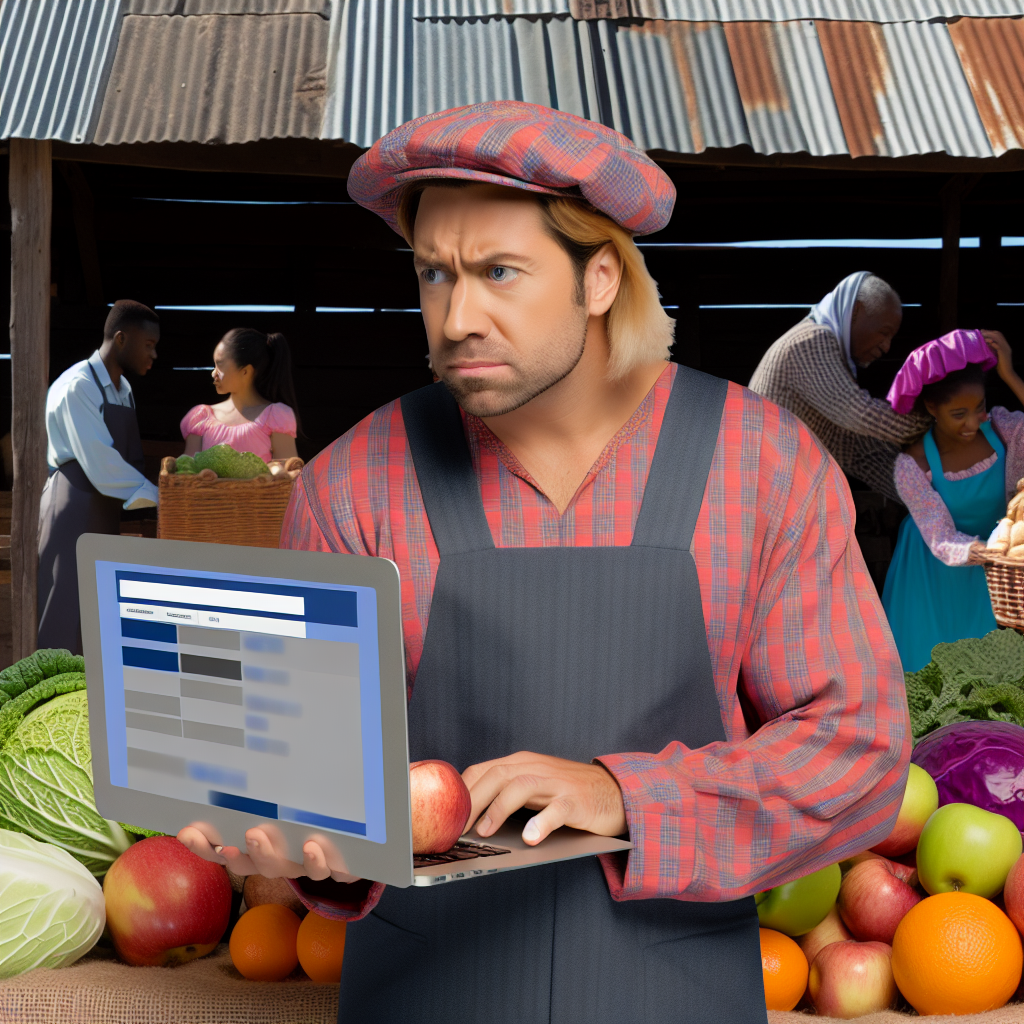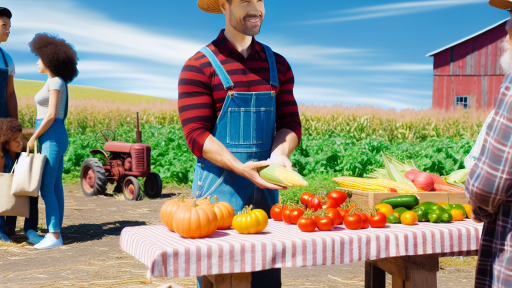Understanding the Direct-to-Consumer Farming Model
Definition and Basics
Direct-to-consumer farming involves farmers selling products directly to customers.
This model eliminates middlemen, thus increasing farmers’ profits.
Farmers can market their goods through various channels.
These include farmers’ markets, online platforms, and farm stands.
Benefits of Direct Sales
Direct sales foster stronger relationships between farmers and consumers.
Consumers appreciate knowing where their food originates.
Additionally, this model allows farmers to respond quickly to market demands.
Farmers gain valuable feedback directly from their customers.
Identifying Challenges
Despite the advantages, farmers face significant challenges in direct-to-consumer sales.
Many farmers struggle with marketing their products effectively.
Additionally, managing logistics can be daunting without established systems.
Farmers often have limited resources for scaling their operations.
Impact of Technology
Technology plays a crucial role in the success of direct-to-consumer sales.
Farmers can utilize social media to reach wider audiences.
Online platforms enable them to track orders and manage inventory efficiently.
Transform Your Agribusiness
Unlock your farm's potential with expert advice tailored to your needs. Get actionable steps that drive real results.
Get StartedHowever, not all farmers are tech-savvy, which poses a barrier.
Consumer Trends
Consumers are increasingly seeking fresh, local products.
This trend supports the growth of direct-to-consumer models.
However, educating consumers about the benefits of local produce is vital.
Furthermore, maintaining consistent product quality is essential for customer retention.
Market Competition: The Rise of Local Farms and Artisan Producers
Increased Competition in Local Markets
Local markets experience a surge in competition.
New farms and artisan producers have emerged rapidly.
This growth provides consumers with diverse options.
However, it creates challenges for existing farms.
Price wars often ensue as producers fight for market share.
Consumers benefit from lower prices but face quality variations.
Building a Strong Brand
To stay competitive, farms must build strong brands.
Effective branding creates a loyal customer base.
Unique stories resonate with consumers.
Artisan producers often connect their products to local culture.
Moreover, transparency in sourcing boosts consumer trust.
Investment in marketing strategies is crucial.
Utilizing Digital Platforms
Digital platforms have transformed market dynamics.
Online sales channels widen consumer reach significantly.
Farmers utilize social media to engage with potential customers.
These platforms enable direct communication and feedback.
Furthermore, farmers can share their stories effectively.
However, competing online requires digital literacy and investment.
Adapting to Consumer Preferences
Consumer preferences are constantly evolving.
Showcase Your Farming Business
Publish your professional farming services profile on our blog for a one-time fee of $200 and reach a dedicated audience of farmers and agribusiness owners.
Publish Your ProfileHealth-conscious choices are on the rise among shoppers.
Local, organic, and sustainable products dominate demand.
This trend pushes farms to adapt their offerings accordingly.
Understanding customer needs fosters brand loyalty.
Market research plays a vital role in staying attuned.
Collaborative Opportunities
Collaboration among local producers can enhance competitiveness.
Joint marketing campaigns leverage mutual strengths.
Collaborative sales platforms can reach broader audiences.
These alliances can reduce costs and increase visibility.
For example, farmers’ markets allow shared resources.
Moreover, partnerships can lead to innovation in product development.
Consumer Trust Issues: Building Relationships with Customers
Understanding Consumer Trust
Consumer trust forms the foundation of successful direct-to-consumer farming sales.
It plays a crucial role in customer decision-making.
Trust affects how customers perceive the quality of products.
Additionally, trust influences repeat purchases and brand loyalty.
Establishing Credibility
Farmers must demonstrate credibility to build consumer trust.
This can be achieved through transparent practices.
Sharing the story behind the farm enhances personal connections.
Moreover, providing detailed information about farming methods builds confidence.
Engaging with Customers
Active engagement is essential for maintaining trust.
Farmers should utilize social media platforms for interaction.
Through social media, they can answer questions directly.
This creates a sense of community around the brand.
Using Customer Feedback
Customer feedback serves as a valuable tool for improvement.
Farmers can gather insights through surveys and reviews.
Listening to customers shows they value their opinions.
This reflection fosters a relationship built on trust and respect.
Building Long-Term Relationships
Long-term relationships with consumers enhance loyalty.
Regular communication keeps customers informed of new products.
This can also include seasonal updates and special promotions.
Additionally, loyalty programs can incentivize repeat purchases.
Addressing Concerns Proactively
Addressing customer concerns proactively is crucial.
Farmers should be transparent about challenges in production.
Honesty about setbacks can build greater trust.
Furthermore, promptly responding to inquiries showcases commitment.
Delve into the Subject: Impact of CSA on Local Farming Communities
Logistics and Distribution Challenges in Direct Sales
Overview of Logistics Challenges
Logistics plays a vital role in direct-to-consumer farming sales.
Efficient logistics ensures timely delivery of fresh produce.
However, many farmers face significant logistical hurdles.
These challenges affect their ability to reach consumers directly.
Showcase Your Farming Business
Publish your professional farming services profile on our blog for a one-time fee of $200 and reach a dedicated audience of farmers and agribusiness owners.
Publish Your ProfileTransportation Limitations
Transportation is one of the most important logistics aspects.
Farmers often struggle with limited access to transportation options.
This limitation can lead to delays in product delivery.
Additionally, rural areas may lack reliable transportation infrastructure.
Farmers must find ways to overcome these transportation issues.
Managing Supply Chain Complexity
Direct-to-consumer sales create a complex supply chain.
Farmers must manage inventory along with demand fluctuations.
This management often requires sophisticated planning tools.
Farmers may also need to collaborate with logistics partners.
Building relationships with reliable distributors is crucial.
Cost Concerns in Distribution
Distribution costs can quickly add up for farmers.
Expenses include delivery, packaging, and storage solutions.
Higher costs may cut into profits, making scalability difficult.
Farmers must evaluate cost-effective distribution strategies.
Investing in local networks could help reduce overall expenses.
Quality Control Measures
Maintaining product quality during distribution is essential.
Farmers face challenges with temperature control during transport.
Improper conditions can lead to spoilage, affecting customer satisfaction.
Implementing strict quality checks can help mitigate these risks.
Farmers should also invest in proper packaging solutions.
Technology Integration
Technological advancements can significantly improve logistics.
Many farmers are beginning to adopt technology for better efficiency.
Use of tracking systems can enhance delivery transparency.
Moreover, data analytics helps predict demand patterns.
Embracing technology can streamline the logistics process.
Gain More Insights: Seasonal Eating Practices for Farm-to-Table Farmers
Regulatory Compliance: Navigating Food Safety Laws
Understanding Food Safety Regulations
Food safety regulations ensure consumer protection and product integrity.
These laws mandate safe handling, preparation, and distribution of food.
Additionally, they set standards for labeling and advertising food products.
State and Federal Regulations
Navigating food safety laws involves understanding both state and federal regulations.
The Food and Drug Administration (FDA) oversees many federal food safety policies.
However, individual states also impose additional requirements.
Farmers must comply with these varying laws to avoid penalties.
Key Compliance Areas
There are several critical areas of compliance for direct-to-consumer farms.
- Food handling practices that minimize contamination risks
- Proper sanitation protocols for equipment and facilities
- Accurate labeling of food products and ingredients
Challenges in Compliance
Maintaining compliance can be challenging for farmers.
Frequent changes in regulations require ongoing awareness and adaptation.
Furthermore, the complexity of local laws can be overwhelming.
Farmers often face difficulties in interpreting and implementing these rules.
Educational Resources and Support
Fortunately, numerous resources are available to aid farmers.
Local agriculture extensions offer workshops to educate farmers about compliance.
Showcase Your Farming Business
Publish your professional farming services profile on our blog for a one-time fee of $200 and reach a dedicated audience of farmers and agribusiness owners.
Publish Your ProfileOnline platforms also provide updated information on regulations.
Moreover, connecting with peer networks can offer valuable insights.
Consequences of Non-Compliance
Failure to comply with food safety laws can lead to severe consequences.
Non-compliance may result in fines, product recalls, or legal action.
Additionally, it can severely damage a farm’s reputation and customer trust.
Proactive compliance efforts help mitigate these risks effectively.
You Might Also Like: Essential Small-Scale Farming Techniques for Beginners
Marketing Strategies: Effective Approaches for Direct Sales
Understanding Your Target Audience
Identifying your target audience is crucial for effective marketing.
Research their preferences and buying behaviors to tailor your approach.
Moreover, segment your audience based on demographics and interests.
This process enhances communication and engagement with your customers.
Building a Strong Online Presence
A robust online presence increases visibility and accessibility.
Develop a user-friendly website that showcases your products effectively.
Additionally, utilize social media platforms to engage with your audience.
Regular updates on these platforms attract and retain customer interest.
Utilizing Content Marketing
Content marketing can establish your authority in the industry.
Create informative blog posts that address customer questions and concerns.
Videos and tutorials can further enhance customer understanding of your products.
Incorporate storytelling to humanize your brand and connect emotionally.
Implementing Email Marketing Campaigns
Email marketing remains a powerful tool for direct sales.
Build a quality email list through sign-ups on your website.
Send personalized messages that resonate with your audience’s needs.
Moreover, regularly share promotions and updates to keep them engaged.
Leveraging Local Partnerships
Partnering with local businesses can boost your visibility.
Collaborate with restaurants or stores that align with your values.
Hosting joint events or markets can foster community engagement.
This approach strengthens both brands and increases direct sales opportunities.
Offering Promotional Incentives
Promotional incentives can effectively drive sales and attract new customers.
Consider offering discounts or seasonal promotions to entice buyers.
Loyalty programs reward repeat customers, encouraging long-term relationships.
Consequently, these strategies can enhance customer retention and satisfaction.
Explore Further: Integrating Agri-Tourism into Your Farm Business

Maintaining Quality and Freshness: Supply Chain Considerations
Importance of Supply Chain Management
Effective supply chain management directly impacts produce quality.
Timely harvest and delivery ensure freshness for consumers.
Thus, farmers must optimize logistics for the best results.
Harvesting Techniques
Harvesting at the right time retains the quality of produce.
Farmers should train staff on efficient harvesting techniques.
Employing best practices reduces spoilage significantly.
Packaging Solutions
Using the right packaging maintains freshness during transport.
Furthermore, eco-friendly packaging attracts health-conscious consumers.
Showcase Your Farming Business
Publish your professional farming services profile on our blog for a one-time fee of $200 and reach a dedicated audience of farmers and agribusiness owners.
Publish Your ProfileFarmers should consider investing in innovative packaging technologies.
Transportation Challenges
Transportation delays can lead to quality degradation.
Farmers must choose reliable logistics partners carefully.
Moreover, climate control during transit preserves product integrity.
Storage Conditions
Proper storage conditions are essential for maintaining quality.
Temperature and humidity controls play a vital role.
Farmers need to monitor storage facilities regularly.
Consumer Expectations
Today’s consumers demand high-quality, fresh produce.
Meeting these expectations requires constant supply chain improvement.
Ultimately, effective management results in higher customer satisfaction.
Technology and E-commerce: Adapting to Modern Selling Platforms
Embracing E-commerce Solutions
Farmers increasingly turn to e-commerce for direct-to-consumer sales.
Online platforms enable them to reach a broader audience effectively.
Using established platforms like Shopify makes this transition smoother.
Additionally, custom websites offer unique branding opportunities.
Social media platforms also play a crucial role in marketing products.
Engaging content can attract potential customers and drive sales.
Integrating Technology in Farming Practices
Technology enhances farming efficiency, benefiting sales directly.
Precision agriculture tools help optimize crop yields and quality.
Farmers use data analytics to understand customer preferences better.
Mobile apps streamline operations by managing inventories and logistics.
Moreover, automation reduces labor costs, increasing profitability.
Navigating Consumer Expectations
Consumers demand transparency in sourcing and production processes.
Farmers must communicate their practices clearly on digital platforms.
Building trust is essential for long-term customer relationships.
Incorporating storytelling into marketing can enhance consumer engagement.
Furthermore, responsiveness to customer feedback improves satisfaction.
Overcoming Technical Challenges
Adopting new technologies can pose challenges for many farmers.
Initial costs for e-commerce setup may discourage some producers.
Technical literacy also varies among farmers, impacting adoption rates.
Training and resources are essential for successful implementation.
Collaborations with tech companies can facilitate knowledge transfer.
Exploring New Market Trends
Staying informed about industry trends is crucial for success.
Farmers must adapt their strategies to meet changing consumer demands.
For example, increasing interest in local and organic products persists.
Additionally, subscription models can enhance steady revenue streams.
Farmers who innovate will stand out in the competitive landscape.
Consumer Education: Overcoming Misconceptions About Local Products
Understanding Local Sourcing
Consumers often misunderstand what local sourcing means.
Many believe that local products are always fresher than imported ones.
However, freshness can depend on various factors beyond distance.
Education plays a key role in clarifying these misconceptions.
Showcase Your Farming Business
Publish your professional farming services profile on our blog for a one-time fee of $200 and reach a dedicated audience of farmers and agribusiness owners.
Publish Your ProfileSupporting local farmers fosters community sustainability.
Quality vs. Price Perception
Some consumers assume local products are more expensive, reducing sales.
It is essential to provide comparisons with mass-produced goods.
Local products may offer superior quality at competitive prices.
Promoting taste tests can effectively illustrate this quality difference.
Highlighting these aspects boosts consumer confidence in local choices.
Health Benefits of Local Products
Consumers often overlook the health benefits of local foods.
Local producers typically use fewer preservatives in their products.
Educating the public on these benefits encourages healthier choices.
Sharing information about nutritional values enhances awareness.
Community workshops can serve as platforms for this education.
Environmental Impact and Sustainability
Consumers frequently lack knowledge about the environmental impact of local farming.
Local farming practices can significantly reduce carbon footprints.
Educating consumers on sustainable practices fosters greener choices.
Highlighting local suppliers’ eco-friendly practices increases interest.
This education can empower consumers to make informed decisions.
Engaging with Local Farmers
Building relationships between consumers and farmers is vital.
Farmers’ markets create opportunities for direct engagement.
Consumers benefit from understanding the farming process firsthand.
Personal stories from farmers can resonate with consumers.
Promoting transparency encourages loyalty to local products.
Pricing Strategies: Balancing Costs with Customer Expectations
Understanding Pricing in Direct-to-Consumer Farming
Pricing in direct-to-consumer farming presents unique challenges.
Farmers must consider both production costs and consumer perceptions.
Effective pricing strategies attract customers while ensuring profitability.
Factors Affecting Pricing
Several factors influence pricing in direct-to-consumer sales.
- Production costs, including labor and materials, play a critical role.
- Market demand affects what consumers are willing to pay.
- Competition from local and organic producers can impact pricing strategies.
Consumer Expectations
Consumers in this market segment expect transparency and value.
They often seek high-quality products at reasonable prices.
Additionally, they value sustainable and ethical farming practices.
Balancing Costs and Customer Satisfaction
Finding the right price requires careful balancing of various elements.
Farmers should calculate their costs to appropriately reflect their value.
Moreover, offering promotions can draw in new customers and encourage repeat business.
Flexible Pricing Strategies
Implementing flexible pricing can help adapt to changing market conditions.
Consider utilizing tiered pricing based on product quality or quantity.
Adjusting prices seasonally can also align with supply and demand fluctuations.
Effective Communication of Value
Communicating the value proposition is crucial for direct-to-consumer sales.
Farmers should emphasize the quality and benefits of their products.
Using storytelling can create a personal connection with consumers.
Exploring Alternative Pricing Models
Exploring subscription models can provide consistent revenue streams.
Community-supported agriculture (CSA) is another viable option.
These approaches can foster customer loyalty and ensure a stable market.
Showcase Your Farming Business
Publish your professional farming services profile on our blog for a one-time fee of $200 and reach a dedicated audience of farmers and agribusiness owners.
Publish Your ProfileAdditional Resources
Farm to Table: Building Local and Regional Food Systems – SARE




